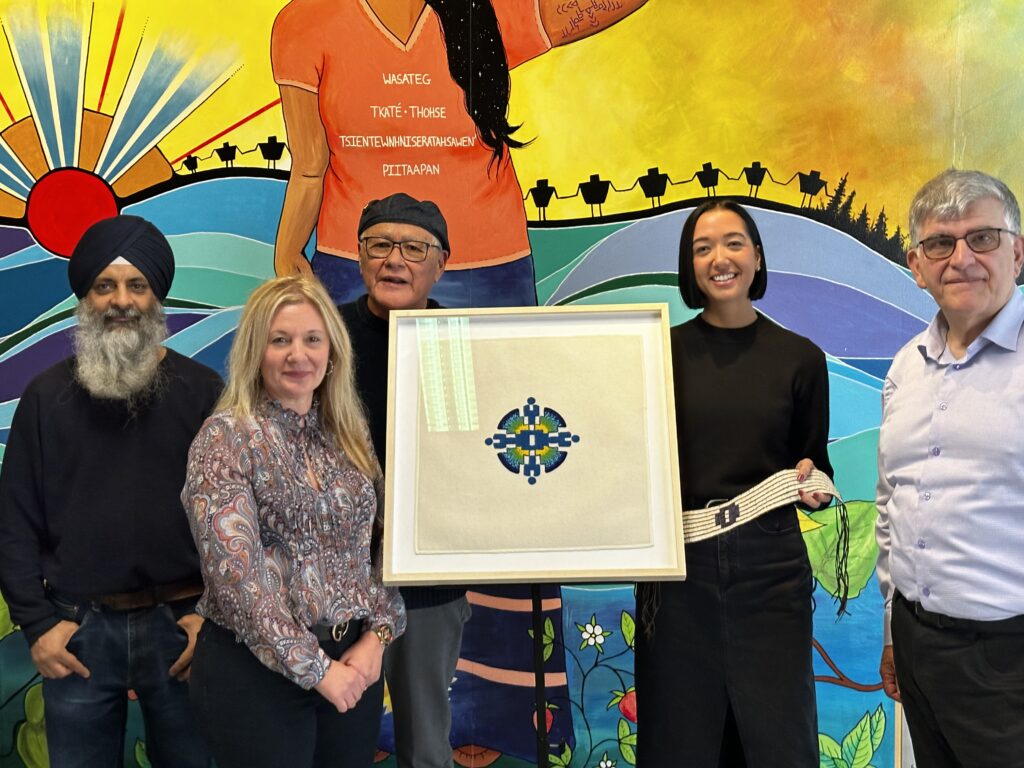
A beaded totem that represents Saagajiwe’s mission and role within the TMU community will soon find its permanent home in The Creative School. The art piece was created by Justine Woods, Indigenous artist and a doctoral candidate in the Media and Design Innovation PhD program at Toronto Metropolitan University.
TMU Provost Dr. Roberta Iannacito-Provenzano, who opened the unveiling event, said the totem will hang in The Catalyst as a display of the University’s commitment to reconciliation and aiding in the revitalization of Indigenous culture.
The beaded totem art piece was originally presented in November 2023, outside of the Saagajiwe Office in the Rogers Communication Centre. At that event, Woods shared that the art piece took her over 100 hours to bead. It was also shown at the 2024 RUBIX showcase, an annual exhibition that celebrates creative works and scholarly research within The Creative School at TMU.
Charles Falzon, the dean of The Creative School said in an email that “Justine Wood’s creation of Saagajiwe’s Totem stands as a powerful embodiment of what our hope is—to share various forms of Indigenous storytelling, celebrating Indigenous sovereignty, and spotlighting the exceptional artistic work by our creative community.”
Saagajiwe was first founded in 2017 as the home for organization, participation and action in the revitalization of Indigenous language, culture, history, creativity and community. It is Saagajiwe’s mission as a department to champion Indigenous language and culture recovery by helping to integrate Indigenous based education within post secondary institutions across the nation.
In an email Woods said, “I am grateful to have been a part of the materialization of these teachings now held within the beads and fabric, and the ways in which this knowledge will continue to be passed down to future community members at The Creative School who visit and interact with it.”
The artwork is a beaded representation of the Saagajiwe totem that depicts four human figures that face the One Dish icon in the center. The Saagajiwe website states that the totem is a visual portrayal of Indigenous heritage in the Great Lakes region that derives from Wendat-Huron Indigenography. In ancient times, the Wendat-Huron People and the League of Five Nations Peoples were told by the ‘peacemaker’ that a tree of peace had been planted on their lands. The roots of this tree spread through the globe in the four sacred directions: North, South, East and West.
The ancient narrative states that the future people who had spread around the world in the four directions would one day follow the roots back to the Tree of Peace. Here, they would take shelter and learn about Indigenous ways of being, ways of knowing and protect themselves from oppression.
“Indigenizing the academy begins with teaching and learning”
Saagajiwe Website
Saagajiwe directly responds to the TRC’s call to action that pushes for post secondary institutions to participate in the recovery and revitalization of Indigenous cultures and languages and recommendations by the United Nations Declaration on the Rights of Indigenous Peoples (UNDRIP) for the recovery of Indigenous languages, cultures, and Knowledges.
An example of the work they do at the centre can be seen in The Saagajiwe’s Indigenous Knowledges Open Source Encyclopedia (SIKOSE). It’s a free and accessible resource that has an inventory of educational tools about Indigenous Knowledges.
Subjects range from cinema and art to treaties and territories. The encyclopedia is a reliable source for researching Indigenous topics and searching for Indigenous knowledge and perspectives on particular subjects.
As a member of the team at Saagajiwe, I have been part of the process of developing projects that will expand SIKOSE, with more digital media based education resources to create a more engaging and friendly virtual learning environment for students, staff and community members.
Saagajiwe has other resources available to students such as a circle room that can be rented for meetings and events. Many nations and communities have a tradition of sitting in the formation of a circle for gatherings to be inclusive and participants can connect with each other. Everyone is considered an equal when gathered in the circle formation.
A computer room is also available for students that are looking for access to a computer and Adobe programs. These resources are available for free to any Indigenous or non-Indigenous students at TMU. If you are interested in inquiring about these resources, contact one of Saagajiwe’s creative practitioners.
